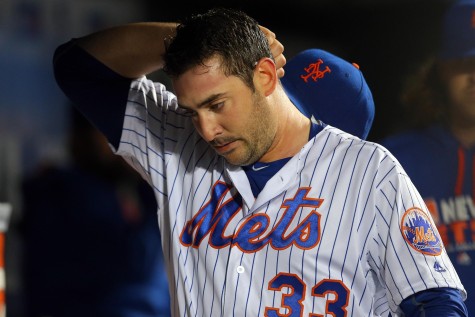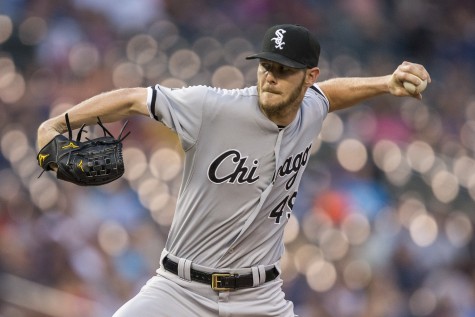
As we all await Matt Harvey‘s next scheduled start on Monday against the first-place Chicago White Sox, we need to be reminded that we could be left disappointed yet again.
Albert Einstein said it best, “the definition of insanity is doing the same thing over and over again and expecting different results.” With that being said, it’s time for Harvey to adjust on the mound.
It’s hard to envision Harvey all of a sudden just clicking in this home game, that all of the velocity worries, arm angles, delivery, and mental lapses will have evaporated and the real Harvey, The Dark Knight version, will reappear, cape and cowl in hand.
The best outcome we can hope for is that Harvey evolves from a flame-thrower who overpowers batters while relying on plus off-speed pitches, to a pitcher who uses location, finesse, and saves a 96-97 mph fastball for when he needs it the most.
The Daily News‘ Kristie Ackert spoke with 86’ Champion and former SNY pre and post-game host Bob Ojeda, and discussed what the 2016 version of Harvey has become thus far.
“He’s out there looking back, looking back for the 97-mile an hour fastball and the Matt Harvey of 2013 and he’s not finding it,” said Ojeda by phone Thursday. “The reality is that he is pitching at 93, 94, 95 miles an hour now. So for two hours every five days, he’s got to find a way to get guys out with that. He has to out-smart them, trick them.”
Ojeda is absolutely correct, what Harvey needs to adapt to in order for him to be an effective member of this starting rotation. Clearly, whatever is ailing Harvey this year, whether it’s physical, mental, or a mixture of the two, Harvey needs to grow as a pitcher and prepare against the opposing teams like a chess match. Learn the hitter’s weaknesses, asses their limitations and what pitches fool them best. I’m sure Harvey, like the rest of the starters, puts a great deal of time into film study and going over lineups before their starts, but it doesn’t seem like it’s resonating with Harvey once he’s out on the mound, especially after the third inning.
Ojeda went on to talk about how other hard throwers in the game have succumbed to losing a few miles per hour on their respected fastballs, but have learned to use what they have in their arsenal, and get outs with that rather than trying to rear back and rediscover velocity that might just not be there anymore.
“People think that throwing a good fastball is throwing it as hard as you can; that’s not it,” Ojeda said. “It’s throwing it as hard as you can with control and that you need to get outs and be able to do that 30 starts a year. That’s what Chris Sale is doing.”

Sale is an excellent example of a guy that has become more of a location guy, rather than trying to blow fastball after fastball by guys. When he first arrived in the Majors, his average fastball velocity was over 96 mph. He was used out of the bullpen in 2010 and 2011, and transitioned to the rotation by 2012. He has seen his velocity go from 94.5 last year, down to 92.5 this year. His swinging strike rate according to Fangraphs, is the lowest of his career, currently at 9.2%. Normally he sits closer to 11-12%, however, he’s pitching to contact, relying on his teammates behind him to make the plays.
And that’s reflected in his O and Z Contact percentage, according to Fangraphs. His O-Contact% (the percentage of times a batter makes contact when swinging at a pitch outside the strike zone) is at 68.6%, almost nine points higher than his previous career high! His Z-Contact% (the percentage of times a batter makes contact when swinging at a pitch inside the zone) is at 85.6%, just one/tenth a percentage point away from his career high back in 2012.
Sale has responded with the lower velocity to a robust 9-1 start to the year. He also has a 2.26 earned run average, struck out 69 in 71 2/3 innings, with a minuscule 0.84 WHIP, second in baseball behind only Clayton Kershaw.
In a recent Sports Illustrated article, Ben Reiter highlighted the transition Sale has made from trying to punch out as many batters as he could, to trying to stay in the game as long as possible. Sale spoke about how he’s viewing his trans-formative season.
“I’m looking for efficiency,” he says. “You can throw 100 miles an hour and punch out 12 guys. But if you’re going five innings, it’s a waste. I want to do everything I can to be as good as I can once a week.”
The White Sox ace goes on to say how creating more movement in his pitches, while sacrificing velocity, creates more ground balls, and weaker contact. When he uses his fielders behind him, he’s prone to see his pitch count shrink, and last longer into games.
“If I take a little off, I get more movement, and it’s down in the zone, which creates more ground balls, more weak contact. I can strike him out and use five pitches. Or I can throw a couple sinkers, and he’s out in two.”
Sale has seen the number of pitches per inning shrink down from 15.9 in 2015, to 14.6 in 2016, which currently places him within the top 15 in that category, as opposed to 43rd last year. Though it might not seem like a lot less pitches, if you add them up throughout six innings, those extra few pitches saved could be the difference in sending him back out for the 7th inning.
He offers a great example of the mindset Harvey needs to learn, which is to pitch to more contact. He’s got a much better tandem up the middle in Asdrubal Cabrera and Neil Walker, and a relatively strong outfield alignment, especially when Juan Lagares is out patrolling center-field. Harvey actually has a better swinging strike rate than Sale does, currently at 10.2%. However, he’s just not able to put away hitters like he has in years past, normally relying on his overpowering fastball to blow past guys.
Ojeda summed his point up best, when he says, “That’s what I had to do,” Ojeda said. “It’s learning to pitch and not just throw as hard as you can.”
Learning to pitch can be difficult, especially when Harvey has been so used to being the alpha dog on the mound, and able to locate his high 90s fastball at any point in the count. Now it’s a matter of changing speeds, locating fastballs, and pitching more to contact that will help push Harvey back into the right direction.
“Pitching is an evolution; you are not always going to have the same stuff start-to-start or day-to-day,” Ojeda said. “The guys who evolve become good pitchers; the world is littered with guys who didn’t evolve with their game.”















